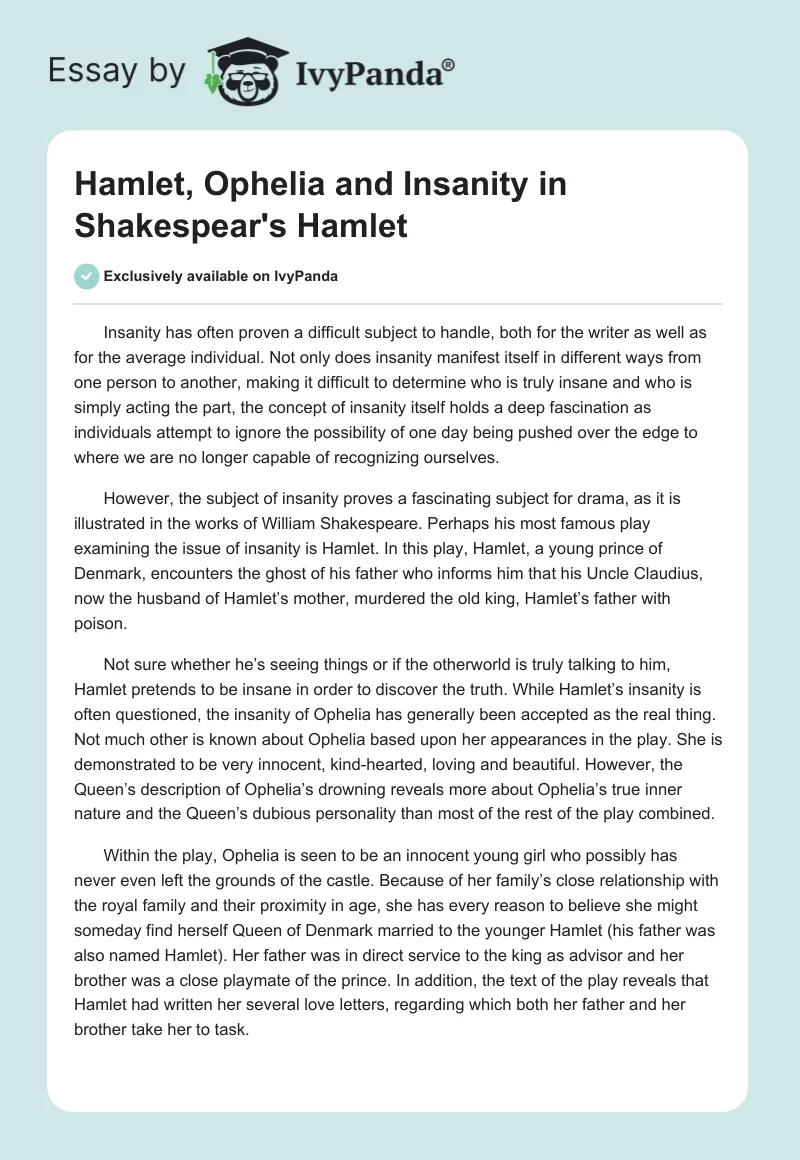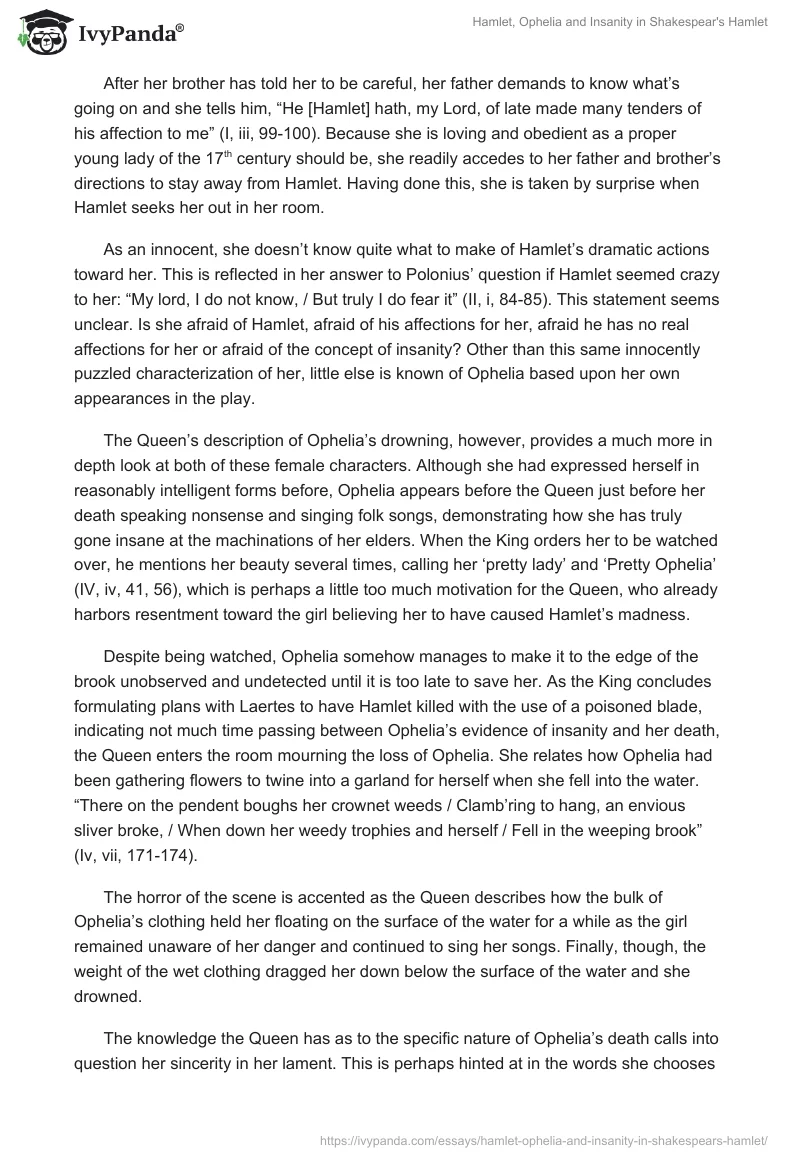Insanity has often proven a difficult subject to handle, both for the writer as well as for the average individual. Not only does insanity manifest itself in different ways from one person to another, making it difficult to determine who is truly insane and who is simply acting the part, the concept of insanity itself holds a deep fascination as individuals attempt to ignore the possibility of one day being pushed over the edge to where we are no longer capable of recognizing ourselves.
However, the subject of insanity proves a fascinating subject for drama, as it is illustrated in the works of William Shakespeare. Perhaps his most famous play examining the issue of insanity is Hamlet. In this play, Hamlet, a young prince of Denmark, encounters the ghost of his father who informs him that his Uncle Claudius, now the husband of Hamlet’s mother, murdered the old king, Hamlet’s father with poison.
Not sure whether he’s seeing things or if the otherworld is truly talking to him, Hamlet pretends to be insane in order to discover the truth. While Hamlet’s insanity is often questioned, the insanity of Ophelia has generally been accepted as the real thing. Not much other is known about Ophelia based upon her appearances in the play. She is demonstrated to be very innocent, kind-hearted, loving and beautiful. However, the Queen’s description of Ophelia’s drowning reveals more about Ophelia’s true inner nature and the Queen’s dubious personality than most of the rest of the play combined.
Within the play, Ophelia is seen to be an innocent young girl who possibly has never even left the grounds of the castle. Because of her family’s close relationship with the royal family and their proximity in age, she has every reason to believe she might someday find herself Queen of Denmark married to the younger Hamlet (his father was also named Hamlet). Her father was in direct service to the king as advisor and her brother was a close playmate of the prince. In addition, the text of the play reveals that Hamlet had written her several love letters, regarding which both her father and her brother take her to task.
After her brother has told her to be careful, her father demands to know what’s going on and she tells him, “He [Hamlet] hath, my Lord, of late made many tenders of his affection to me” (I, iii, 99-100). Because she is loving and obedient as a proper young lady of the 17th century should be, she readily accedes to her father and brother’s directions to stay away from Hamlet. Having done this, she is taken by surprise when Hamlet seeks her out in her room.
As an innocent, she doesn’t know quite what to make of Hamlet’s dramatic actions toward her. This is reflected in her answer to Polonius’ question if Hamlet seemed crazy to her: “My lord, I do not know, / But truly I do fear it” (II, i, 84-85). This statement seems unclear. Is she afraid of Hamlet, afraid of his affections for her, afraid he has no real affections for her or afraid of the concept of insanity? Other than this same innocently puzzled characterization of her, little else is known of Ophelia based upon her own appearances in the play.
The Queen’s description of Ophelia’s drowning, however, provides a much more in depth look at both of these female characters. Although she had expressed herself in reasonably intelligent forms before, Ophelia appears before the Queen just before her death speaking nonsense and singing folk songs, demonstrating how she has truly gone insane at the machinations of her elders. When the King orders her to be watched over, he mentions her beauty several times, calling her ‘pretty lady’ and ‘Pretty Ophelia’ (IV, iv, 41, 56), which is perhaps a little too much motivation for the Queen, who already harbors resentment toward the girl believing her to have caused Hamlet’s madness.
Despite being watched, Ophelia somehow manages to make it to the edge of the brook unobserved and undetected until it is too late to save her. As the King concludes formulating plans with Laertes to have Hamlet killed with the use of a poisoned blade, indicating not much time passing between Ophelia’s evidence of insanity and her death, the Queen enters the room mourning the loss of Ophelia. She relates how Ophelia had been gathering flowers to twine into a garland for herself when she fell into the water. “There on the pendent boughs her crownet weeds / Clamb’ring to hang, an envious sliver broke, / When down her weedy trophies and herself / Fell in the weeping brook” (Iv, vii, 171-174).
The horror of the scene is accented as the Queen describes how the bulk of Ophelia’s clothing held her floating on the surface of the water for a while as the girl remained unaware of her danger and continued to sing her songs. Finally, though, the weight of the wet clothing dragged her down below the surface of the water and she drowned.
The knowledge the Queen has as to the specific nature of Ophelia’s death calls into question her sincerity in her lament. This is perhaps hinted at in the words she chooses to illustrate what caused Ophelia to fall, ‘an envious sliver’. Within the Queen’s account of the events of Ophelia’s death, the only sign of doubtfulness is the inclusion of the words ‘But long it could not be’ before she tells the King and Laertes that Ophelia’s “garments, heavy with their drink, / Pulled the poor wretch from her melodious lay” (IV, vii, 180-181).
Other than these few words, the Queen seems quite well informed regarding the details of Ophelia’s death which suggest a first-hand knowledge rather than the second-hand guessing that would have occurred had no one been witnessing the action. She tells the men, “Her clothes spread wide, / And mermaid-like awhile they bore her up, / Which time she chanted snatches of old lauds, / As one incapable of her own distress” (IV, vii, 174-177).
With motive in her new husband’s admiration and anger at the girl’s rejection of her son, plus the reasonable assurance that she would not suffer any negative repercussions for the death and given the short time frame in which the death occurred, the actions of the Queen must be called into question regarding Ophelia’s death and, perhaps, in the death of the old king as well.
The purpose of this speech is to reveal a more accurate picture of the characters involved in the play. The Queen’s poetic description of Ophelia’s end serves to indicate the innocence and beauty of the young girl’s soul, dying as she did in complete ignorance of what was happening to her. She didn’t feel fear or demonstrate any knowledge that she was facing what, to many, seems a most frightening experience.
In addition, the Queen indicates Ophelia’s purity of spirit by associating it with the water element, itself a sign of purity. Ophelia’s death, then, is more like a rebirth into her true and intended form rather than the tragic accident it seems. However, this speech also serves to highlight the possibly treacherous aspect of the Queen, indicating that perhaps she isn’t quite the innocent fool she appears to be through Hamlet’s eyes.
While she appears to have been helpless in her decision to take her brother-in-law as husband following the death of Hamlet’s father, the speed with which this union took place, however justified, has continued to call question upon her complicity in the murder or her true knowledge of the events. This intimate knowledge of the details of Ophelia’s death further indicates that perhaps the Queen is not helpless or innocent in either tragedy. With these types of hints, her death at the end of the play doesn’t seem as much a tragedy as it does an act of divine justice.
Works Cited
Shakespeare, William. “Hamlet.” The Complete Pelican Shakespeare. New York: Viking, 1969, pp. 930-976.


